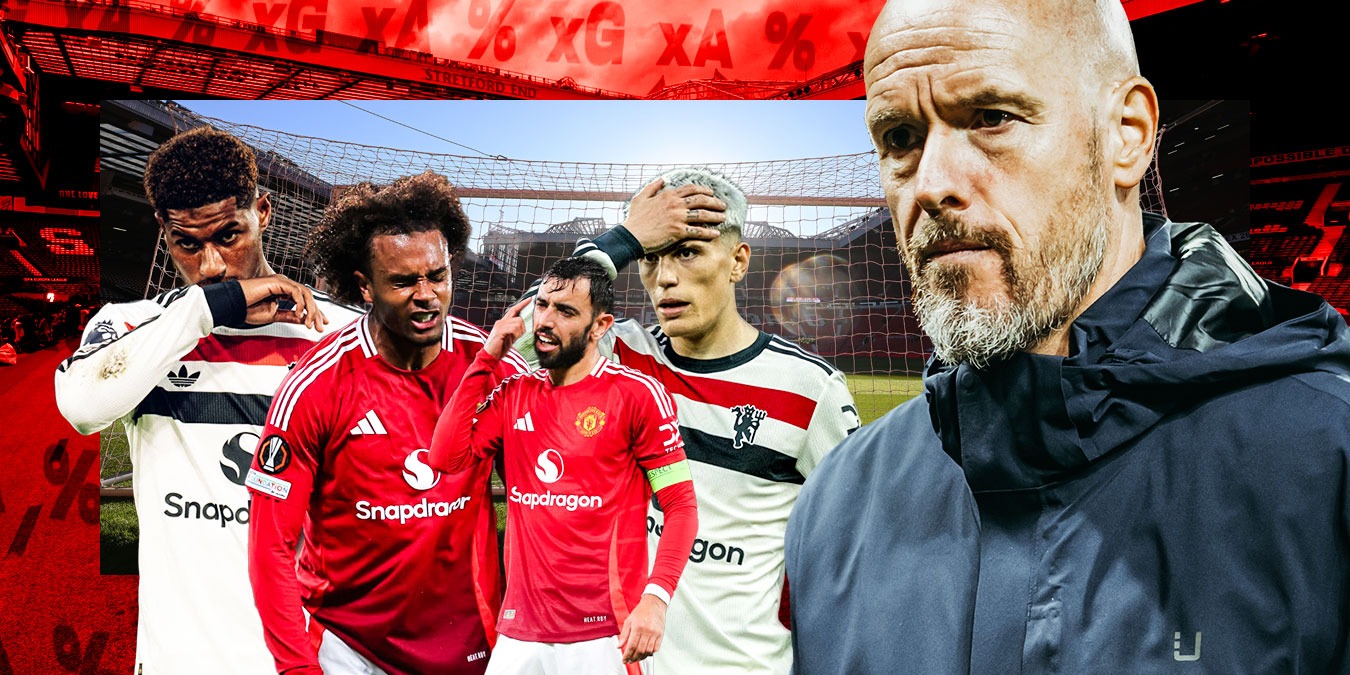Aside from thrashing League One opposition, Manchester United are struggling in front of goal this season. But it could be worse; at least they’re creating quality chances.
There was a feeling of positivity around Manchester United as their season began in August. Their work in the transfer window was generally praised as they addressed key areas and weaknesses; a new hierarchy that gave the impression of real competence was in place; and fans would get to see Kobbie Mainoo and Alejandro Garnacho again, this time potentially taking on even more important roles.
But with September almost over, it still feels like fans are waiting for United to turn up, with their form on paper showing little deviation from the erratic ups and downs of last season.
Wednesday’s surprise 1-1 UEFA Europa League draw with Dutch side FC Twente at Old Trafford was the latest disappointment as United failed to win their opening European match for the fourth season in a row.
While it stands to reason that most clubs at this level – yes, even in the Europa League – should be capable of at least giving anyone a decent game, and Twente have started the Eredivisie season in decent shape, before a ball was kicked in Europe, Twente were given just a 0.3% chance of winning the tournament by the Opta supercomputer, putting them among the nine least-fancied clubs in the competition alongside the likes of Qarabag (0.2%), Ludogorets (0.1%) and Ferencváros (0.1%).
Furthermore, Wednesday was Twente’s first European game (excluding qualifiers) since late 2012. They’re hardly regulars, let alone contenders.
Erik ten Hag, a former Twente player of course, after the game lamented what has become a familiar theme for United: their killer instinct, or lack of.
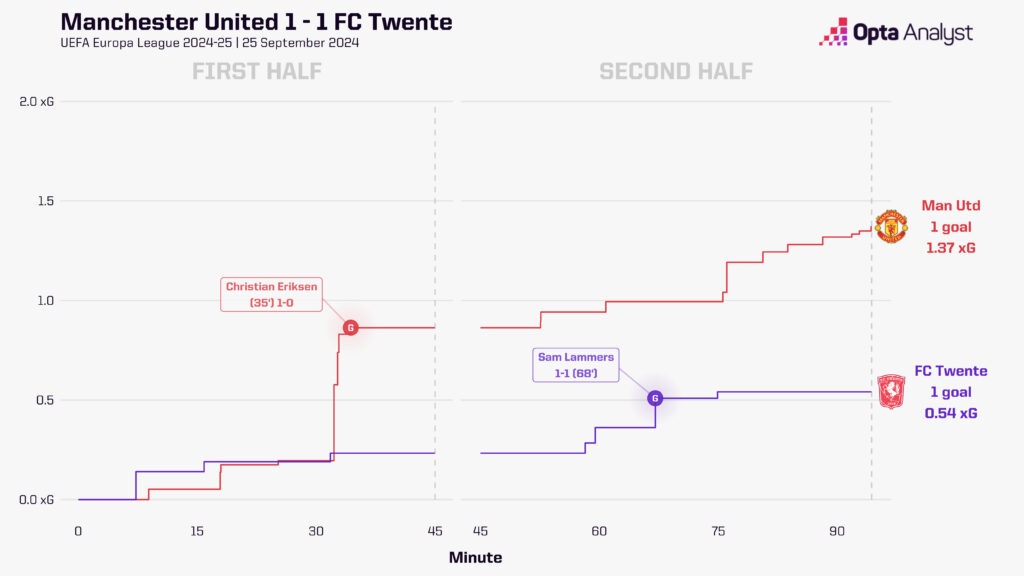
“We kept them alive,” he told TNT Sports. “One-nil up, controlling the game, you have to be consistent and keep going. In the second half we dropped the level and gave a goal away. We didn’t finish it off, we had to go for the second goal. They stayed alive and we got punished with a mistake from ourselves.”
Ten Hag had addressed the situation in his pre-match press conference as well, insisting United were “capable of scoring many goals” before acknowledging it was an area they needed to improve, demanding them to “kill in the box”.
They didn’t. A Christian Eriksen scorcher aside, United were unimpressive in front of goal and they paid the price for that, with Sam Lammers scoring a second-half equaliser following a catalogue of errors from the hosts.
So, how much of a problem is United’s form in front of goal?
If you take the numbers at face value, it doesn’t look that concerning. They’ve played eight times in all competitions this season, scoring 14 goals. At 1.75 per game, it’s hardly amazing but it’s also not terrible.
But these figures are obviously warped by the 7-0 win over Barnsley in the EFL Cup. While you can only beat the team that’s in front of you, should a game against third-tier opposition really be given equal weighting as games versus Premier League teams? Probably not.
Now, it might seem almost a little revisionist to start highlighting United’s form in front of goal when you consider they scored seven just eight days prior to Wednesday’s stalemate, but that match was very much an outlier.
If we ignore that fixture, United’s goals per game of 1.0 in all competitions this term is among the worst of all Premier League teams, with only Bournemouth and Ipswich Town (0.83) netting at a lower frequency.
Then, if we look solely at the Premier League, United’s goals-per-game rate remains 1.0, a better record than only Crystal Palace (0.8), Ipswich (0.6) and Southampton (0.4).
Whichever way you slice it, that’s not great, but it’s also important to understand the quality of the chances United are creating. Is this an issue with their creators simply not delivering, or are high-value opportunities actually quite common?
Well, one way we can attain a degree of insight is by looking at the average expected goals (xG) value of United’s shots. Now, given we are still working with only a few games worth of data, it doesn’t take many big opportunities to boost the figures quite considerably, but it still provides us with a decent barometer of the quality of chances being created.
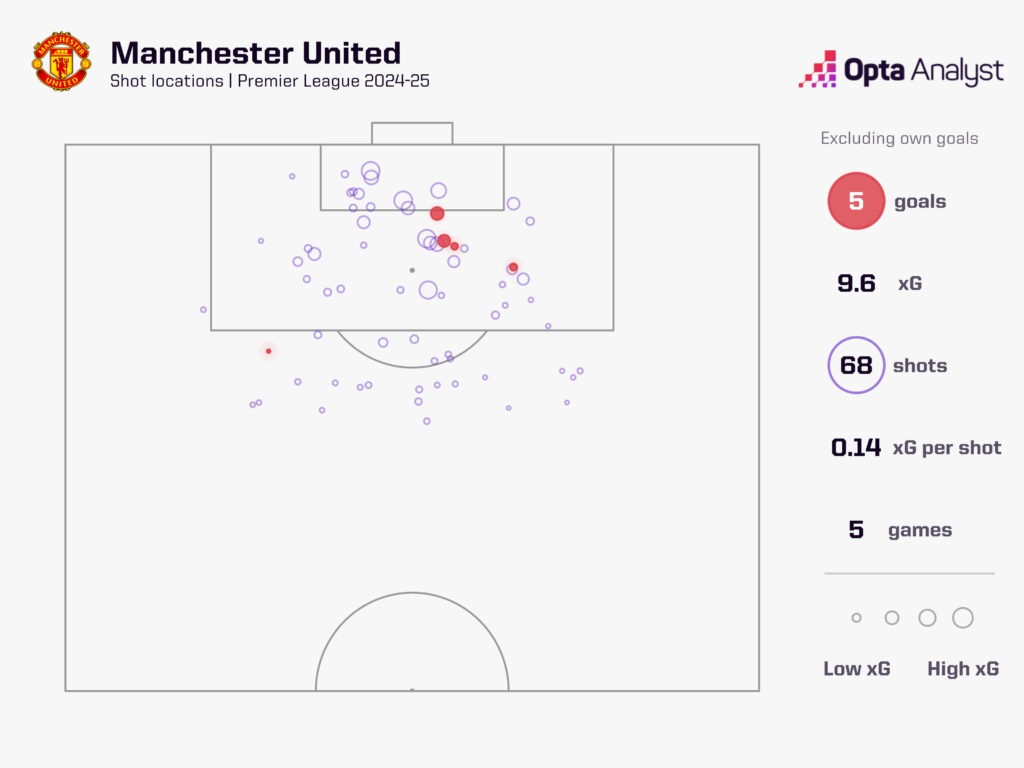
United’s 68 shots in the Premier League this season equates to 9.59 xG – that averages out to 0.141 per shot, which is the highest in the top flight over the first five matchdays. And, considering they’ve not had a penalty in the league yet this term, that figure isn’t inflated by the fact a spot-kick automatically carries an xG value of 0.79.
Six clubs may have recorded more attempts in total, but United’s xG is bettered only by Manchester City (11.46) and Liverpool (10.1). That tells us creating opportunities hasn’t been an issue – if anything, they’ve actually been quite effective at carving out chances.
But making the most of those chances, especially high-value ones, has been a problem.
For instance, only Man City (7) have created more opportunities worth at least 0.4 xG than United (6), but Ten Hag’s men haven’t scored any of those. The only other teams not to score any goals from shots worth at least 0.4 xG are Ipswich and West Ham, with both sides managing to craft just two such chances.
Although there is a slight caveat with one of those United chances being the Garnacho shot against Brighton that would’ve counted as a goal had it not hit the offside Joshua Zirkzee on the goal line, there’s still a case to answer regarding United’s wastefulness.
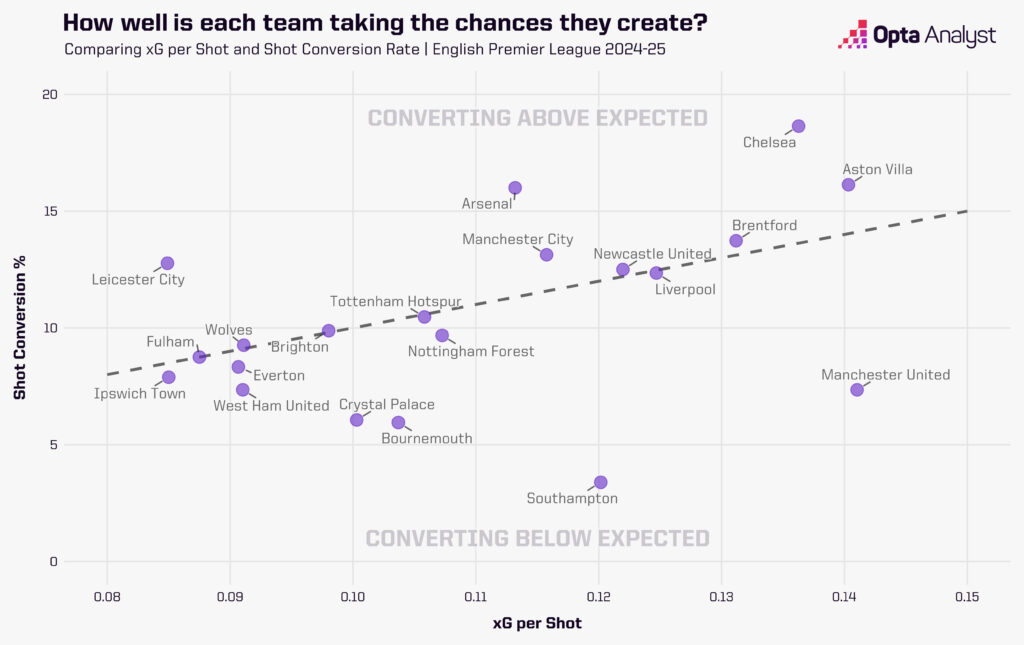
Their shot conversion rate in the Premier League this term is just 7.4%, better than only Southampton (3.4%) and Crystal Palace (6.1%). Again, we have to remember that five matches is a small sample size, but were they to maintain that level over the full campaign, it’d be their worst season on record (since 2003-04) for converting chances.
Just to put that into wider historical context, Sunderland were relegated in 2016-17 with a better shot conversion rate (7.5%).
Perhaps it shouldn’t be surprising, then, when we see that United have only spent 15% of their total match time this season in the lead; just four teams have been ahead for a smaller proportion of their games in 2024-25.
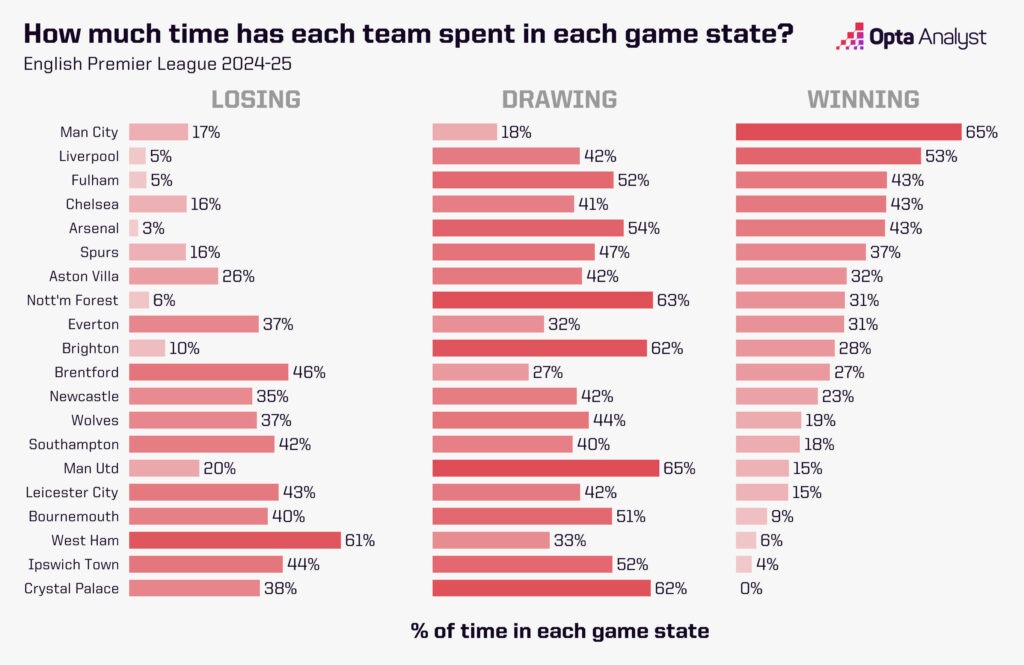
Bruno Fernandes has been especially inefficient in front of goal. He’s had the most shots (17) of any player not to score in Europe’s top five leagues this term. In fact, in the Premier League, only three players in total have registered more attempts than him.
His shots equate to 1.86 xG, meaning only Cameron Archer (-2.29) and Evanilson (-1.96) have underperformed in relation to expected goals by a greater margin than him. Zirkzee – one goal from 2.19 xG – and Garnacho – one goal from 2.17 xG – are just two and three places respectively behind Fernandes. Though we again have to point out Garnacho’s record is unfortunate because of the mishap against Brighton.
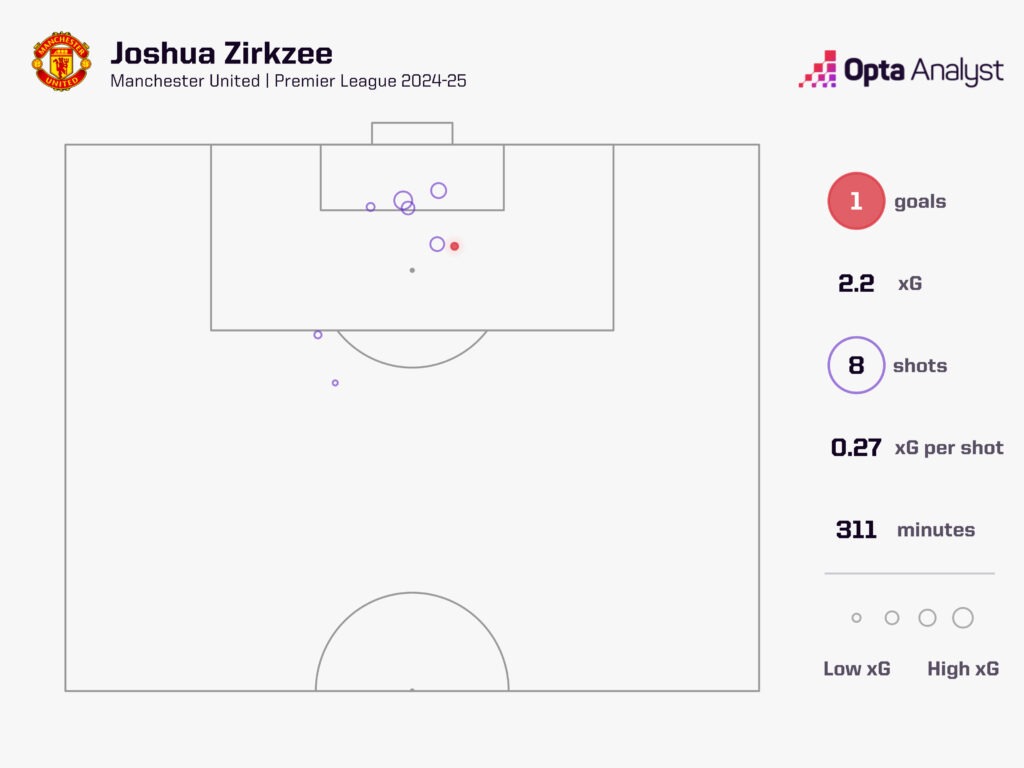
In the case of Zirkzee, there were never great expectations of him scoring a truckload of goals after a relatively modest haul of 11 in Serie A last term. He has at least shown himself to be adept at holding up the ball and his link play is often excellent, with Wednesday’s game showing more promising signs of a budding understanding with Marcus Rashford.
But at a time when most of United’s forwards are flattering to deceive in front of goal, it’s easy to see why Zirkzee’s role might come under scrutiny. His 19 touches in the opposition’s box this season is the same number as Manchester City’s Rico Lewis. Sure, City are a more dominant team and we always knew Zirkzee wasn’t going to be an Erling Haaland-type striker, but it makes you wonder if he could operate closer to the box more often.
After all, the Netherlands international has shown he can get into dangerous positions, with his 0.27 xG average per shot the most of anyone in the Premier League (minimum four shots) this term.
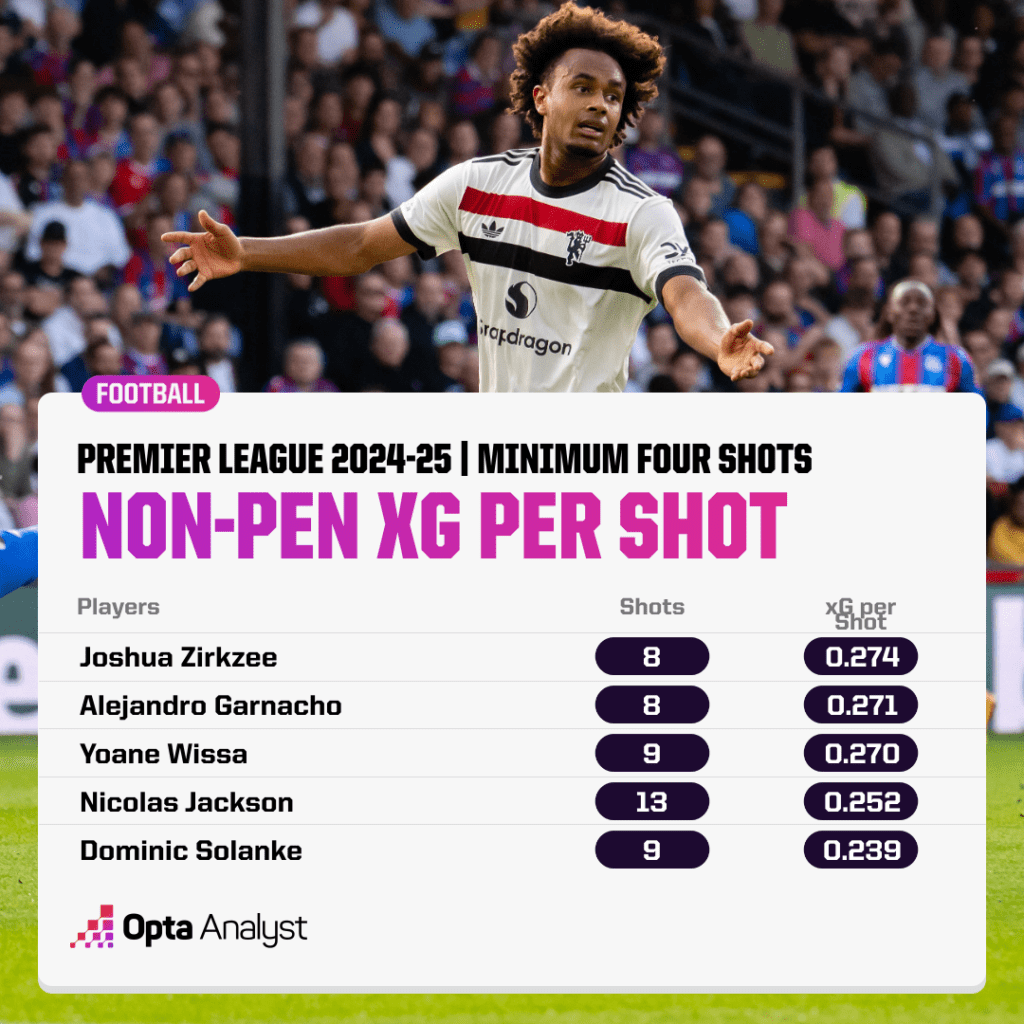
Rasmus Højlund’s return from injury will offer them something different, too. The Dane can play on the last shoulder, he’s quick and did improve in front of goal after a shaky first few months last season. However, the jury’s still out on whether he has what it takes to be a regular and reliable source of goals.
United find themselves with that classic conundrum of creating quality chances but not finishing them. Some will argue it’d be a bigger problem if they weren’t even creating them, and perhaps that’s the case.
So, in one sense, there’s a reason for positivity, and United will presumably be confident they’ll soon get the rub of the green and these high-value opportunities start getting converted.
But, if the clear-cut chances dry up, like they did to some extent on Wednesday, Ten Hag will have to rely on United conjuring goals out of nothing, and that’s a risky fallback strategy.

Enjoy this? Subscribe to our football newsletter to receive exclusive weekly content. You can also follow our social accounts over on X, Instagram, TikTok and Facebook.
